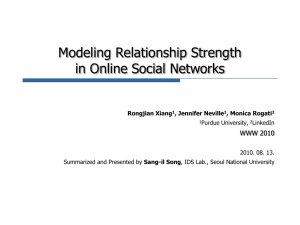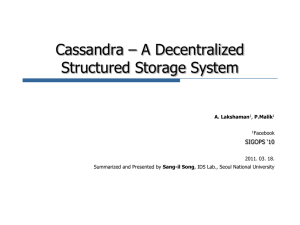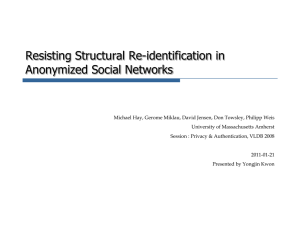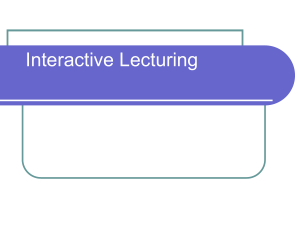Discovery-Driven Graph Summarization
advertisement
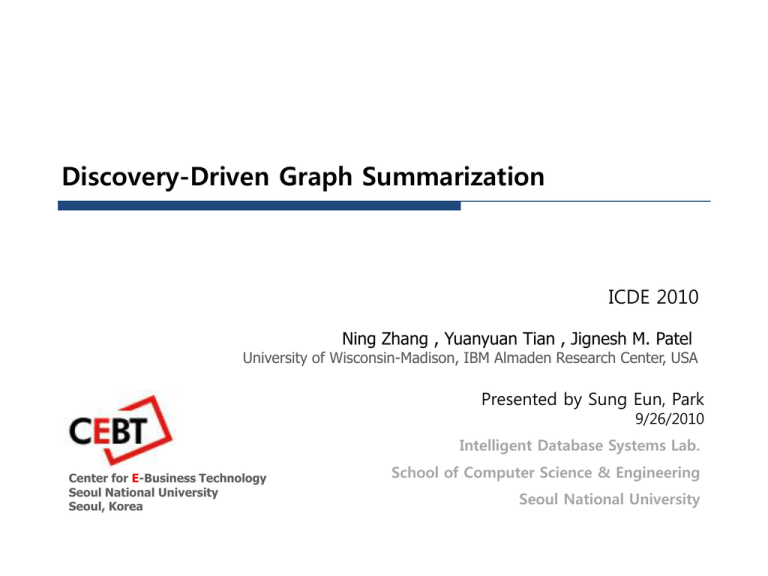
Discovery-Driven Graph Summarization
ICDE 2010
Ning Zhang , Yuanyuan Tian , Jignesh M. Patel
University of Wisconsin-Madison, IBM Almaden Research Center, USA
Presented by Sung Eun, Park
9/26/2010
Intelligent Database Systems Lab.
Center for E-Business Technology
Seoul National University
Seoul, Korea
School of Computer Science & Engineering
Seoul National University
Contents
Introduction & Preliminaries
k-SNAP Summarization
–
Efficient Aggregation for Graph Summarization(Sigmod’08)
Categorization of Numerical Attributes
CANAL algorithm
–
Try to Merge Groups and Select Cutoffs
Automatic Discovery of Interesting Summaries
Measuring Interestingness of Summaries
Automatic Discovery of Interesting Summaries
Experimental Results
Conclusion
Copyright 2010 by CEBT
2
Introduction
Large Graph datasets are ubiquitous!
Graph summarization can assist in uncovering useful insights
about the patterns hidden in the underlying data
Proposed Graph Summarization Approach (previous work)
Copyright 2010 by CEBT
3
Preliminaries
Proposed Graph Summarization Approach (previous work)
A summary graph by grouping nodes based on user-selected
node attributes and relationships
Author
Research
Field
The # of
Publication
Coauthor
a1
DB
5->LP
a2, a10
a2
DB
10->MP
a1, a3
a3
AI
30->HP
a2, a6
…
…
10->MP
a1
5->LP
OS
DB
a2
DB
DB
a2
10->MP
DB
AI
a3
30->HP
AI
AI
a4
DB
a3
a5
30->HP
a5
a6
AI
23->HP
a6
18->MP
28->HP
8->LP
28->HP
Copyright 2010 by CEBT
4
Preliminaries
Proposed Graph Summarization Approach (previous work)
SNAP : Nodes of each group are homogeneous with respect to
user-selected attributes and relationships.
–
May result in a large number of small groups, in the worst case each
node may end up an individual group.
k-SNAP : users can control the number of groups in the summary
graph as k.
→
<k-SNAP: Top-down approach>
Copyright 2010 by CEBT
< k-SNAP : different resoultion>
5
Preliminaries
k-SNAP
Strong
relationship
Weak
relationship
Low/Moderately/Highly
Cited groups
Link represents the
participation rate
participation rate=
(The num berof nodes participated in the relationship)
(The num berof nodesin both groups)
Copyright 2010 by CEBT
6
Preliminaries
Δ-measure
How different it is to a hypothetical “ideal summary”
Given a graph G, the Δ-measure of a grouping of nodes
Φ = {G1, G2, ..., Gk} is defined as follows:
For Every pair of
groups , sum…
Differences to the
ideal summary
Small Δ value indicates good summary
Copyright 2010 by CEBT
7
Introduction
k-SNAP
Produces summaries which themselves are also graphs
Two limitations
1.
k-SNAP uses categorical node attributes, but even for domain experts,
providing clear cutoffs is tricky and not always possible.
→introduces CANAL alg’m that automatically categorize
numerical attributes values based on both the attributes values
and the link structures of nodes in the graph
2.
k-SNAP allows summaries with different resolutions, but users may
have to go through a large number of summaries until some
interesting summaries are found.
→ propose a measure to assess the interestingness of
summaries
Copyright 2010 by CEBT
8
Automatic Discovery of Interesting Summaries
CANAL algorithm
Input: Graph G, Numerical node attribute value a, Desired number
category : C
Intuition : Find cutoffs that increases Δ value the most.
Calculate
Δ increases
G1
G2
G3
nodes that contains
same attribute value
G4
Gk
…
…
Numerical
node attribute
Value
Every iteration.. Until there is only one group left
–
Pick the adjacent pair that has the most similar relationship pattern to the
other groups
–
Merge the pair and calculate Δ increases after
–
Pick C-1 cutoffs that has the biggest Δ increases
Copyright 2010 by CEBT
9
Automatic Discovery of Interestingness Summaries
Copyright 2010 by CEBT
10
Automatic Discovery of Interestingness Summaries
Copyright 2010 by CEBT
11
Experimental Setting
Datasets
DBLP DB Dataset : Bibliography data
–
Coauthorship graph(undirected)
NODE : authors, 7,445 nodes
EDGE : coauthorship, 19,971 edges
Attirbute : publication number
CiteSeer Dataset
–
Citation graphs(directed)
NODE : article and a directed
EDGE : a citation
Attirbute : Number of citations
Copyright 2010 by CEBT
Experimental Result
Effectiveness of the CANAL algorithm
cutoffs generated by CANAL vs. cutoffs manually selected in the
previous work
The cutoffs produced by CANAL results in Δ/k values that are
very close to the manually selected ones.
Δ measure
(good summary
has small value)
Copyright 2010 by CEBT
Experimental Result
Efficiency of the CANAL Algorithm
Execution time of the CANAL algorithm nicely scales with
increasing data sizes
–
C=3, note that different C values do not significantly affect the run
time of the CANAL algorithm, because all the cutoff candidates are
considered.
Copyright 2010 by CEBT
Experimental Result
Effectiveness of the Interestingness Measure
Interestingness of summaries
Copyright 2010 by CEBT
Experimental Result
Two types of Interesting summaries
Overall Summary
–
Conciseness is relatively small : k=4
–
Coverage : the nodes participating to the strong relationship ↑& -
–
Diversity : ↑ as much as LP of size 2680 & -
Copyright 2010 by CEBT
Experimental Result
Two types of Interesting summaries
Informative Summary
Only strongly
collaborate to
HP
–
Conciseness : a little bigger than “overall summary”
–
Coverage : ↑ as much as new LP group of size 1261,-
–
Diversity : ↑ as much as new LP group of size 1261, -
Copyright 2010 by CEBT
Only show
weak
relationship
Conclusion
Overcome two key limitations in the previous work
introduces CANAL algorithm that automatically categorize
numerical attributes values based on both the attributes values
and the link structures of nodes in the graph
propose a measure to assess the interestingness of summaries
Copyright 2010 by CEBT
Q&A
Thank you
19


